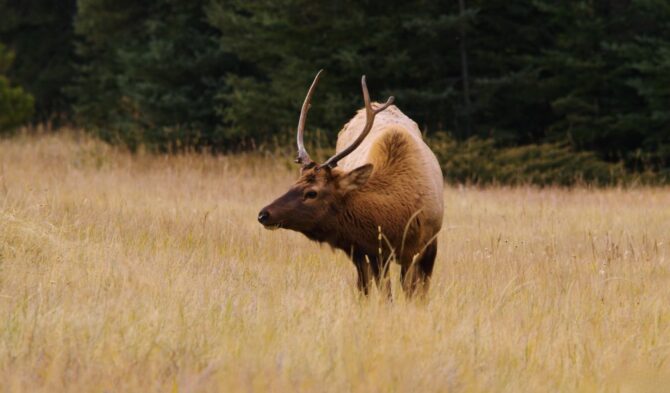Southern California refers to the southern parts of California state. The latter is nicknamed the golden state because of its history with gold, and it has since been a flourishing region ever since.
You can find a little over 280 parks (both national and otherwise) alongside different habitats like redwood forests and deserts. Among the different animals in the southern part of the state, we have owls.
There are more than ten species of owls in Southern California to identify. Some examples are the barred owl, burrowing owl, Flammulated owl, and Elf owl, among others.
Read on to discover the interesting facts about these birds and how to identify the various species based on their appearance, sounds, and migratory patterns.
The 14 Species of Owls in Southern California
1. Elf Owl
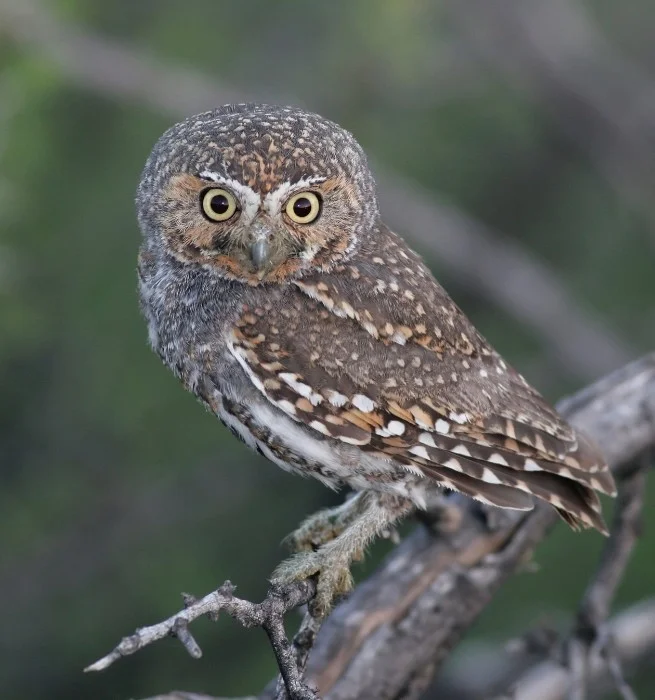
- Length: 5 to 6 inches
- Weight: 1 to 2 pounds
- Wingspan: 10 to 10.5 inches
- Scientific name: Micrathene whitneyi
First on our list is the world’s smallest owl and the lightest. The elf owl is about the size of a sparrow, and it can comfortably fit into one’s palms.
There are other small species, like the long-whiskered owlet and Northern pygmy, but they are not as diminutive as the elf owl.
The elf owl is described as being very small, with no ear tufts and a large head. It also has an overall gray-brown color.
Because it is small and nocturnal, you need to listen out for the owl’s sound, as it may be hard to find.
The call is a whinny or chuckle, and it is high-pitched. Males tend to have more sounds than females.
These birds often live in southern California during the summer and spring, inhabiting cavities made by woodpeckers.
In winter, they move to Mexico. Southern California falls under their breeding range.
Their small sizes make them vulnerable to predators, but they hunt as well. They feed on arthropods, insects, and scorpions.
2. Flammulated Owl
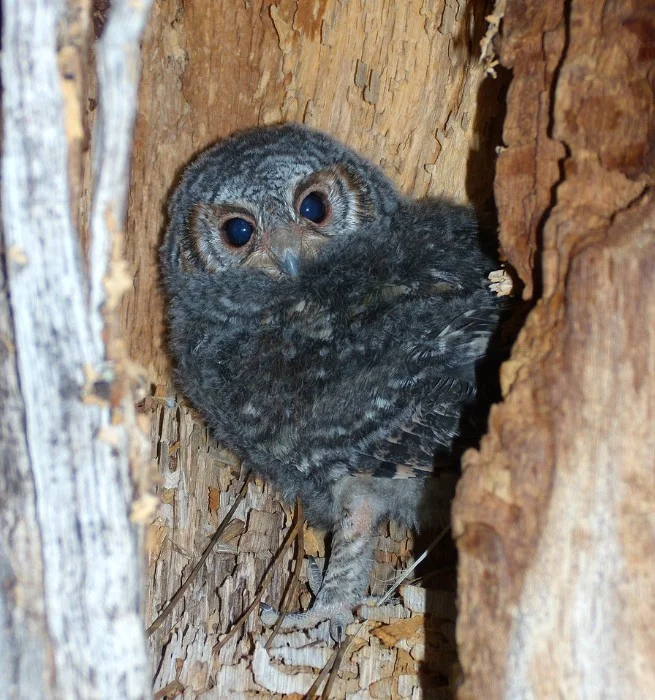
- Length: 6 to 7 inches
- Weight: 1.5 to 2 pounds
- Wingspan: 15 to 16 inches
- Scientific name: Psiloscops flammeolus
The flammulated owl is another small species, though not as small as the elf owl. It is a very shy bird and camouflages enough to hide away from human sight.
This makes it hard for people to see the flammulated owl. The best way to know it is there is through sound.
The flammulated owl hoots, and the sound can be deep, a single call or double. Because the call isn’t loud, it may often sound farther away than the bird. You’d have to take note of that.
The flammulated owl is only found in Southern California during its breeding season.
In looks, the flammulated owl is similar to the western screech owl. However, there are some differences, including size (the western screech is bigger) and a lack of ear tuft.
The defining feature of the flammulated owl is a flame-like marking on the face, which earns it the name. It also has dark eyes.
The size notwithstanding, this bird is a voracious eater. It feeds mainly on insects like beetles, crickets, and moths, using its size as an advantage to grab prey with ease.
In South California, you would often locate a flammulated owl during late spring and early summer.
3. Burrowing Owl
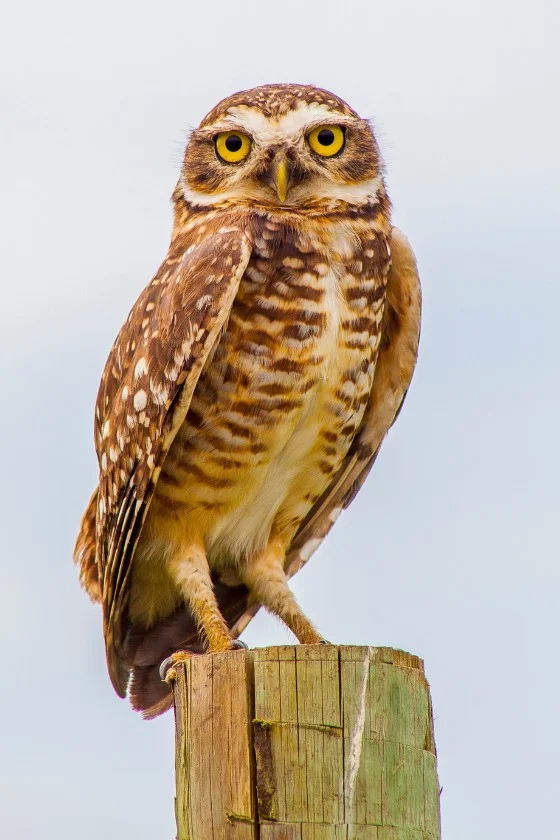
- Length: 7 to 11 inches
- Weight: 5 to 9 pounds
- Wingspan: 20 to 24 inches
- Scientific name: Athene cunicularia
The burrowing owl is so named because of its living habits. It often dwells in burrows left by other animals.
It is small and long-legged, which helps it stay in the open habitat where it puts the leg to good use. Preferred habitats include grasslands, rangelands, deserts, and other agricultural areas.
These birds can be in Southern California all year round, though some hang around during the breeding period.
Besides the long legs, other characteristics of the burrowing owl are bright eyes, a dark yellow/gray beak, a brown head, and wings.
The burrowing owl hunts more during dusk and dawn, but it is usually active during the day. When hunting at dusk, it uses its night vision and hearing to locate prey. It feeds primarily on rodents and insects.
4. Barn Owl
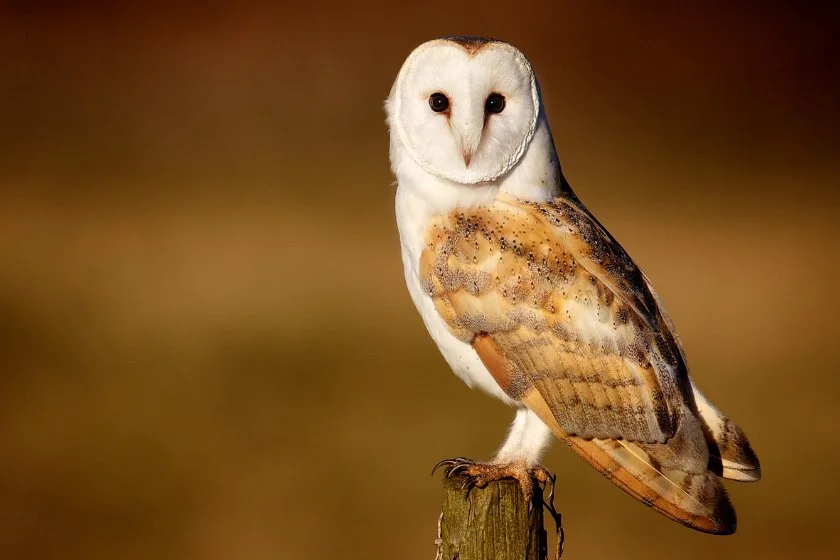
- Length: 13 to 16 inches
- Weight: 14 to 25 pounds
- Wingspan: 40 to 50 inches
- Scientific name: Tyto Alba
The barn owl is the one species you can easily find in many places as it is the most widespread owl.
It occurs in every continent except Antarctica, and you can find it in abandoned barns, hence the name. It is very common in Southern California and also lives in habitats like lowlands.
The barn owl is also known as the common barn owl to distinguish it from other species that it is related to.
Other names it goes by include church owl, monkey-faced owl, and even the demon owl.
The latter is due to its ominous appearance and the shriek. The barn owl has an overall pale brown and grey plumage, but the eerie part is its black eyes.
The barn owl is primarily nocturnal but can sometimes hunt by day in places like Britain.
It feeds largely on rodents and other small mammals but will also adapt to other prey like birds, fish, and insects.
5. Barred Owl
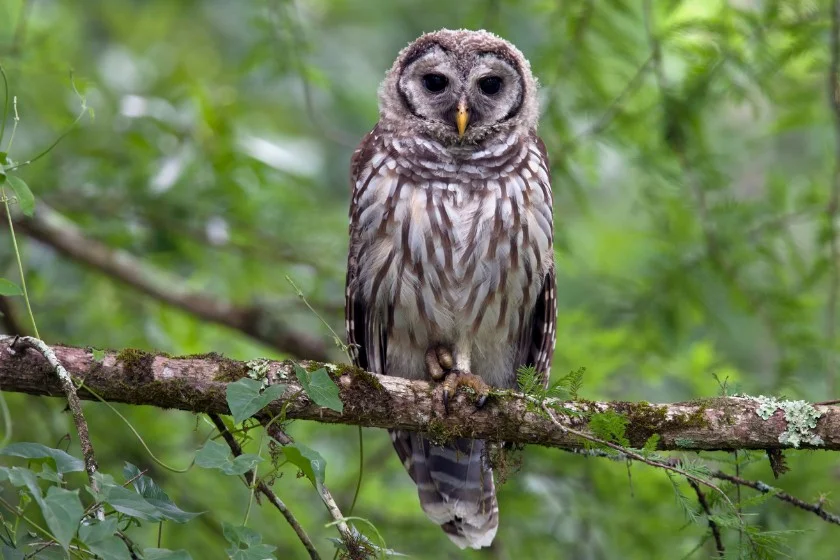
- Length: 17 to 20 inches
- Weight: 16 to 37 pounds
- Wingspan: 39 to 43 inches
- Scientific name: Strix varia
The barred owl is also known as the northern barred owl, the hoot owl, and the striped owl. The names reflect the hooting sound and the stripes on its feathers.
It has broad wings with tips that help it fly silently, and it often stays close to the swamps and forests near rivers. It is close to rivers it gets its prey.
These species live longer compared to others in this list, with the longest recorded individual living up to 34 years.1
In Southern California, it is quite rare. These birds are often found in Northern California, as well as other parts of the United States.
Their defining features are the hooting sound and bars we mentioned above, but they have more.
They’ve got a large head, brown eyes, and plumage that’s generally gray and brown.
The barred owl feeds on many invertebrates as well as vertebrates like birds, reptiles, and amphibians.
It is very nocturnal, often beginning its hunting after sunset. It has other birds as enemies, so it can’t be considered an apex predator.
6. Great Gray Owl
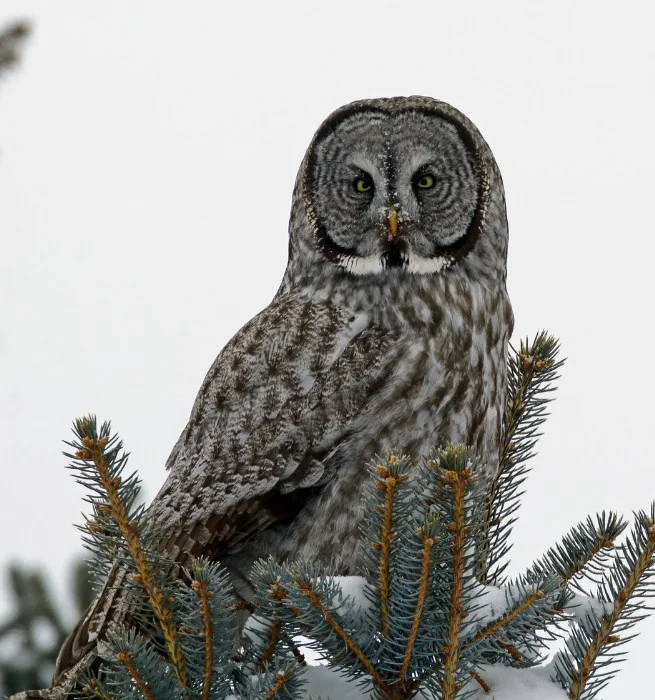
- Length: 24 to 33 inches
- Weight: 25 to 60 pounds
- Wingspan: 54 to 60 inches
- Scientific name: Asio flammeus
The great gray owl is also called the Phantom of the North, spruce owl, bearded owl, Lapland owl, and sooty owl.
It is considered the tallest bird in North America and arguably the entire world, even more than birds like the Eurasian eagle owl and the Blakiston’s fish owl.
At first glance, this creature’s size can be scary. However, it is not known to pose any risk.
In Southern California and other parts of the state, the great gray owl is common and can be found year-round.
It has broad wings, a big head, and yellow eyes, all of which can help identify it. Its overall color is gray, just as the name implies.
It has a large facial disc but no ear tufts. While it does make hooting sounds, the adult is usually silent. Young ones may make more sounds like shrieking, hissing, or chattering.
The bird can go after prey that seems too big for other owls. While it often feels on rodents, it can also go after moles, hares, hawks, ducks, and weasels, among others.
7. Long-eared Owl

- Length: 14 to 16 inches
- Weight: 8 to 15 pounds
- Wingspan: 36 to 40 inches
- Scientific name: Asio otus
The long-eared owl is often located in North America and other places like Europe and the Palearctic.
It is also called the northern long-eared owl, the cat owl, and the lesser horned owl. This bird’s outstanding features are the long feather tufts and the catlike face.
The individuals in Southern California can be found all year round, and they are easy to identify. Besides the prominent features, also look out for a slim figure and long wings.
The color of its plumage combines gray and brown. No one is sure what the long feather tuft is for, but it might be for communication.
The long-eared owl feeds mainly on rodents, and as such, it is a specialized predator. However, it can expand its diet to also feed on birds and insects.
8. Short-eared Owl
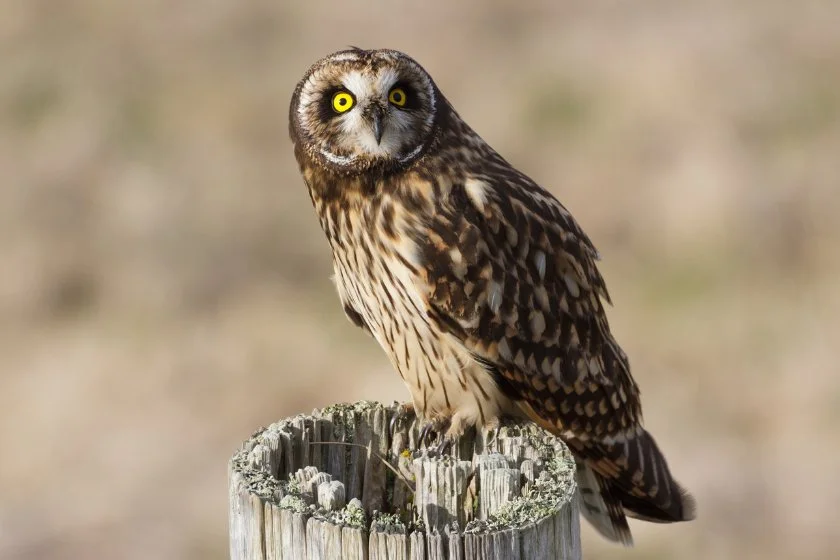
- Length: 14 to 17 inches
- Weight: 7 to 17 pounds
- Wingspan: 34 to 41 inches
- Scientific name: Asio flammeus
The short-eared owl is a relative of the long-eared owl, both belonging to the same genus Asio. This is also quite evident in their names.
The feather tufts are short and not always visible, and the bird has broad wings. Its plumage is usually brown. It can be found all year in Southern California, often inhabiting open fields and meadows.
Other physical features that you can look at to recognize the short-eared owl include large eyes, a big head, and an almost invisible neck.
The tail and wings are barred, and it flies irregularly because of the wingbeat.
The sounds it makes either go like waowk, waowk, waowk, or toot, toot, toot, toot. It occasionally makes a loud eeeeee-yerp sound while breeding.
This bird is one of the most widespread in the world, existing in all continents except Antarctica and Australia.
It can be diurnal, crepuscular, or nocturnal, but it is known to hunt often at night. It feeds on rodents, squirrels, bats, moles, etc.
9. Northern Pygmy Owl
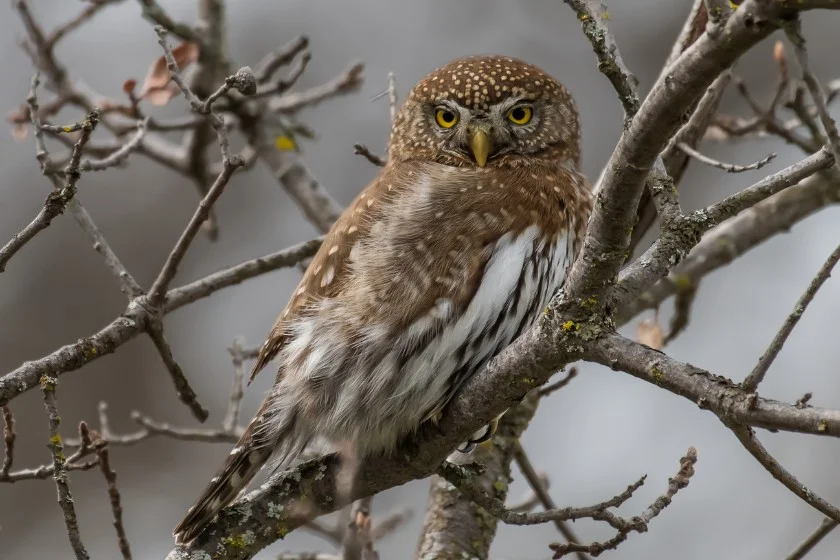
- Length: 6 to 7 inches
- Weight: 2 to 3 pounds
- Wingspan: 12 inches
- Scientific name: Glaucidium californicum
The Northern pygmy owl is a native of western North America, and it is just as small (though not equally so) as the elf owl.
It is also cute looking, and an owl people look out for when owling. It is challenging to find, but the best spots are forests, wooded canyons, or thickets.
This bird occurs mainly in the Northern and coastal areas of California but can sometimes be seen in the south. It remains in the state throughout the year.
The good thing about the Northern pygmy owl is that it comes out during the day. This gives you a better chance of seeing it.
With a small bird like the Northern pygmy, pay more attention to the sound. It has a loud tooting call you should familiarize yourself with.
You can also look for songbirds making a fuss. These birds are not big fans of the northern pygmy and would often try to chase it away.
The size notwithstanding, the Northern pygmy owl is a ferocious hunter. It can go after bigger prey like the California quail, though it is often contented with eating small mammals, sunbirds, and large insects.
10. Northern Saw-whet Owl
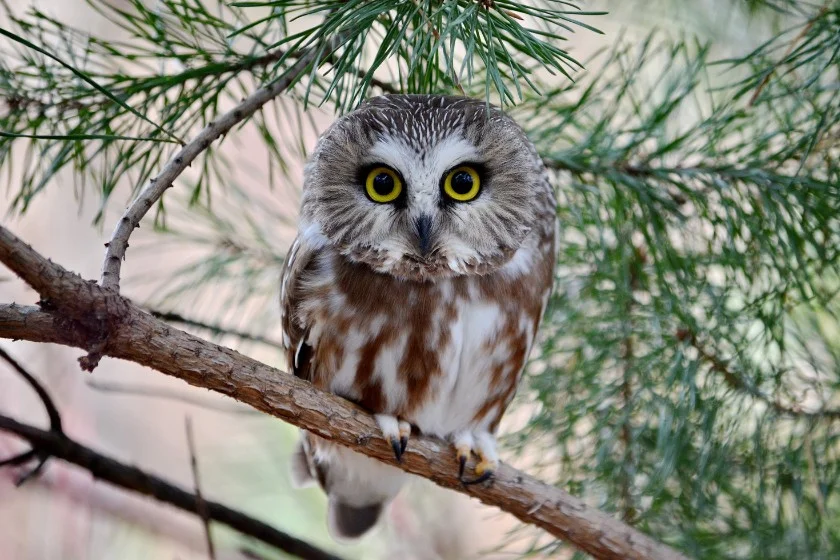
- Length: 7 to 9 inches
- Weight: 2 to 5 pounds
- Wingspan: 17 to 22 inches
- Scientific name: Aegolius acadius
The Northern saw-whet owl is a native of North America, a species of small owl that’s considered one of the smallest in the continent.
It is a migratory bird with no pattern, staying in the dense forests and woodlands of Southern California. It is also very close to humans and can be found around residences.
The saw-whet owl is more common in the northern parts of California, and it occurs all year. In the central and southern areas, it may not occur all year.
This species can be hard to locate because of its size, secretive nature, and color. The latter is brown with some white and streaks of cream.
It is also as small as a robin, stays motionless, and escapes being seen. The best way to notice it is the sound.
The saw-whet owl got its name from its distinctive sound, which many people describe as a saw being sharpened on a whetstone.
It is known to be easygoing and to perch on a tree, either looking for prey or enjoying the weather. It feeds on small mammals and birds.
11. Western Screech Owl
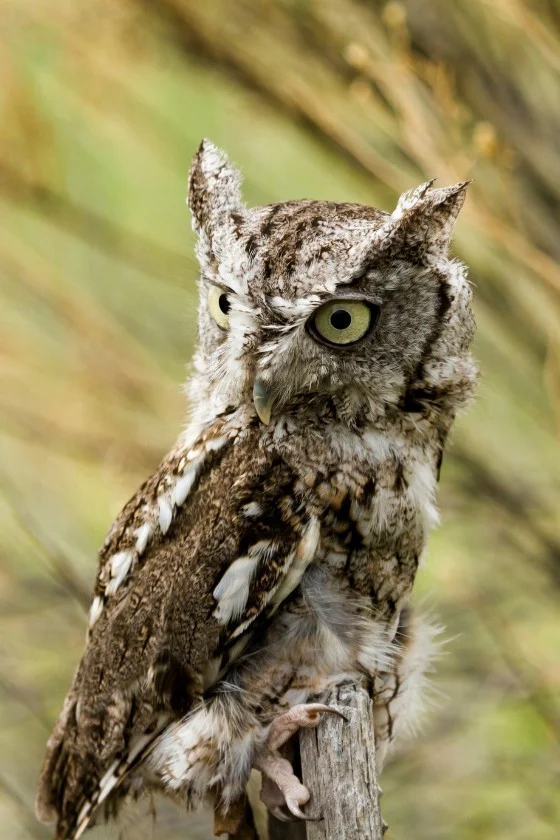
- Length: 8 to 10 inches
- Weight: 4 to 11 pounds
- Wingspan: 22 to 25 inches
- Scientific name: Otus kennicottii
The western screech owl is a native of North and Central America, and it is one of the most common owls in Southern California.
It resides in the state all year, and while it is hard to find one because of its nocturnal nature, it is still possible.
The fastest way to recognize a western screech owl when you see one is by its round head, ear tufts, yellow eyes, and yellow bill.
Its colors are either brown or gray, and it comes with a streak at the underparts. Females are usually larger than males.
It is similar to the eastern screech owl and another species called the whiskered screech. Because of this resemblance and the nocturnal nature, most people prefer listening to sound.
The western screech owl screeches, just as the name implies. It isn’t limited to screeching, however. The screech owl also barks, chuckles, and whistles.
12. Spotted Owl

- Length: 18 to 25 inches
- Weight: 32 to 88 pounds
- Wingspan: 40 to 57 inches
- Scientific name: Bubo virginianus
The spotted owl is listed as endangered due to habitat loss, which makes it hard to find in Southern California.
It is also nocturnal and competes with the barred owl, further increasing the challenges.
That being said, it occurs year-round in the state, which is good news for enthusiasts.
There are more spotted owls in the northern side of California than in the south, so if you’re peculiar about finding this species, the best side is up north. That said, there are a few populations in the south.
The spotted owl feeds on a variety of rodents and other mammals like bats, as well as birds.
Its hunting strategy involves sitting and waiting for the right prey to approach. When that happens, it pounces.
13. Great-horned Owl

- Length: 18 to 25 inches
- Weight: 32 to 88 pounds
- Wingspan: 40 to 57 inches
- Scientific name: Bubo virginianus
The great horned owl is a true owl and the most widely distributed of its kind in America.2 This distribution is thanks to the bird’s adaptability.
Its preferred habitats include rainforests, deciduous forests, coniferous and mixed forests, deserts, tundras, rocky coasts, etc.
The great horned owl fits the stereotype. For starters, it hoots, an attribute that earned it the name hoot owl. It also has a large head with long tufts, cat-like eyes, and a stocky body.
It is colored a mottled brown and a light underpart. Added to this is a white patch seen at the throat. All individuals have a facial disc.
The great horned owl is nocturnal and uses camouflage to its advantage when hunting. It feeds on small mammals and a host of other animals.
14. Snowy Owl
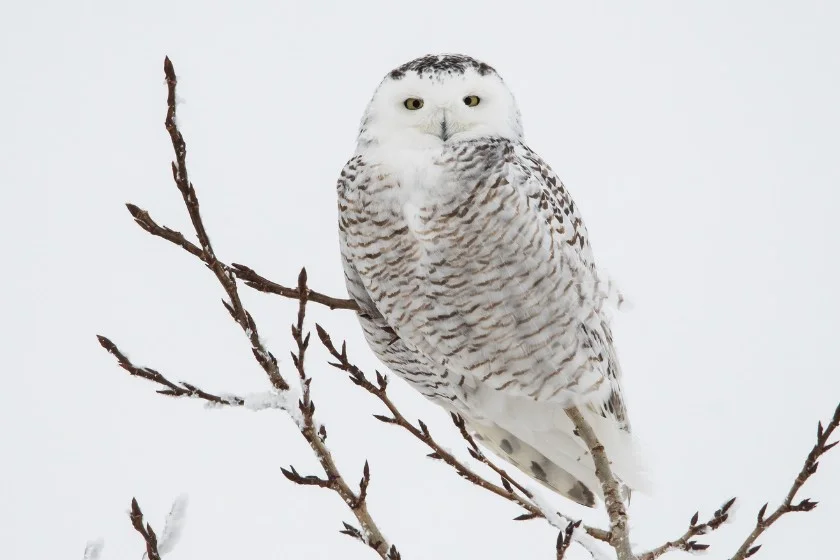
- Length: 21 to 28 inches
- Weight: 56 to 104 pounds
- Wingspan: 50 to 57 inches
- Scientific name: Bubo scandiacus
The snowy owl is one of the most unique owls in the world because of its white plumage and size. It is sure to stop you in your tracks if you come across one.
This bird is a native of the arctic tundra and goes by other names like the polar owl, the artic owl, and the white owl.
It is rare in southern California and many other states but does come around in some years.
You’d often see these birds in the northern parts of California during the winter. Occasionally, they may come to the south, but you’re more likely to see snowy owls in places like Canada.
While the snowy owl is white, rarely would you see one that’s fully so. The common rule is that they have some dark spots.
Females have darker spots than males, and as a snowy owl grows, it tends to get whiter. It also has yellow eyes and a small head.
The snowy owl is a ferocious hunter and has been known to even take on artic owls. Its common diet is lemmings, but it can feed on many other animals like water birds and even carrion.
Conclusion
Southern California has many attractive features, including all 14 owls listed in this article. Some can be found all through the year, while others appear during some seasons.
Which species would you like to see? Leave it in the comments below!
Next up…
References & Notes
- Orfinger B. A., Helsel D., Breeding F. S. 2018. Longevity of the Barred Owl (Strix varia Barton, 1799) from captivity. The Wilson Journal of Ornithology.
- Great Horned Owl. The Peregrine Fund.

